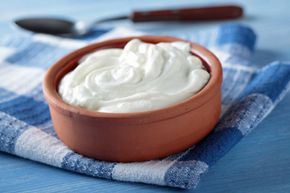If you've been down the yogurt aisle at your local grocery store, you know that there's a wide variety of styles and flavors to choose from. You can buy Turkish or Greek yogurt. Go non-fat or low fat. Organic, soy or frozen. Fruit on the bottom or fruit stirred in. Plain, blueberry, key lime pie. Some yogurts even claim to improve digestion or help you lose weight. How do you choose?
Of course, it hasn't always been this way. The tangy mixture probably originated thousands of years ago, as early as 7000 B.C.E., in the Middle East. Back then, nomads carried milk in gourds or sacks made from animal skins [source: Chandan]. Without refrigeration, the milk would've warmed and curdled during the voyage. When the travelers arrived at their destination there it was -- sour milk. Bacteria already present in the milk transformed or fermented it into a thicker substance, giving it that tart taste that you might be able to distinguish if you can get past the jams and sweeteners used in most yogurts on the shelves today.
Advertisement
But the addition of sweeteners is partly behind the yogurt craze here in the United States. Sugars took away some of that sour bite, which prompted Americans to delve deeper into a product that other countries were already in love with. In 1980, Americans ate more than 570 million pounds (258.5 million kilograms) of yogurt. In 2008, that jumped to 3.6 billion (1.6 billion kilograms) [source: Schultz].
Major yogurt companies eventually capitalized on the notion of yogurt as a health or functional food. This certainly helped the industry grow in a country that was becoming increasingly concerned with its waistline. So, are the claims of healthfulness warranted?




